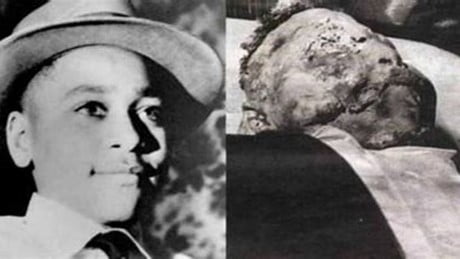As the saying goes, “a picture is worth a thousand words.” Now it’s a thousand words that yours truly aims not to exceed in publications I write for. So I humbly sacrifice more than half of my word limitation to three images embedded in what you’re about to read.
So, fair warning readers!
The first image is graphic and may be disturbing. I include it here to make the point that as a nation we’re still mired in issues of race – think Trayvon Martin, George Floyd and Sandra Bland, to name a few – all murders occurring a half century removed from the death of Emmett Till in Mississippi in 1955. Although Till’s death happened almost a century after slaves were freed, his killing is a painful reminder of the residual effects of racism in America that continues to this day. Where once we could write murders of African Americans off as exceptions and not norms, the use of cell phone camera flips that notion on its head, doesn’t it?

Like images of our nation’s signature atrocities, among them protesters being fire hosed and pummeled with Billy clubs as they walked off Edmund Pettus bridge in Selma and the knee on the neck of a dying George Floyd, the mutilated face of Emmett Till is still another watershed moment in the sordid history of race in America.Top of FormBottom of Form
Okay, to make this personal, my oldest grandson turned 14 recently. Now although there’s no ancestral connection between the two, 14 was Emmett Till’s age when he was murdered in 1955. What’s also compelling for me is that although both Emmett and my grandson are different in skin color – he light skinned and my grandson shades darker – they have similar round faces wrapped around by charming smiles, giveaway dimples, a love for sports and magnetic personalities. So in a way when I see Emmett, I see my grandson and the faces of scores of other African American grandsons in America. Let’s shift now to another, perhaps less disturbing, image; that of President Joe Biden who recently named a new national monument honoring Emmett Till and his mother amid a national debate over how to teach painful facts about American history in classrooms.
“In a time when there are those who seek to ban books, bury history, we’re making it clear, crystal, crystal clear: While darkness and denialism can hide much, they erase nothing,” Biden said at the White House, where he and members of the Till family gathered to formally approve the new monument.
“We can’t just choose to learn what we want to know,” Biden said. “We have to learn what we should know. We should know about our country. We should know everything. The good, the bad, the truth. Telling the truth and the full history of our nation is important. We’ve got a hell of a way to go.” So contrast the preceding images with that of the Florida governor putting his signature on mandates that not only ban “Critical Race Theory” and “wokeism” (neither of which he can define) but unleashed his opportunist minions to mandate teaching the “benefits” of slavery to middle schoolers. Humm, one is left to wonder how Florida would sugarcoat the Emmett Till story.

In the end, we’re confronted by still another choice along the rocky road that lies before us during this critical junction in our racial history. Do we go back, or do we forge ahead?
Wrote Robert Frost in his poem, The Road Not Taken, “Two roads diverged in a wood, and I took the one less traveled by.”
Now tell us, which road America?”Terry Howard is an award-winning trainer, writer, and storyteller. He is a contributing writer with the Chattanooga News Chronicle, The American Diversity Report, The Douglas County Sentinel, Blackmarket.com, co-founder of the “26 Tiny Paint Brushes” writers guild, recipient of the 2019 Dr. Martin Luther King, Jr. Leadership Award, and third place winner of the 2022 Georgia Press Award.

